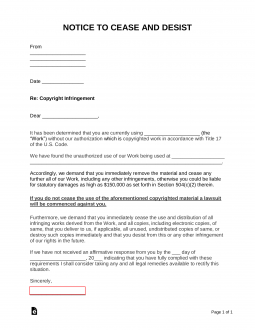Updated June 23, 2023
A copyright © cease and desist is a letter that is sent to an individual or entity that has violated an owner’s proprietary information commonly consisting of physical or electronic media. Due to the difficulty in searching registered copyrighted material, in order to protect media files, it is recommended to have the word “copyright” or “©” along with the year it was created.
Copyright © Search – Official database to look-up a registered copyright.
Laws – 17 U.S. Code Chapter 5 (Copyright Infringement and Remedies)
Written Notice (17 U.S. Code § 501(b)) – A written request must be made before a lawsuit can be filed. If the copyrighted work is on a website it is best to contact through the WHOIS Database via email or the registered mailing address.
How to Send
This is only a “warning” that legal action will be pursued if the party on the receiving end does not cease or quit the usage of the copyrighted material.
Step 1 – Perform a Search of the Copyright

The owner of the copyright must first prove they have the right to the copyrighted material. This can be completed by using the United States Copyright Office Search Tool and looking up by name, title, keyword, registration number, document number, or command keyword.
After making the query, the next screen will show copyrighted listings with its Title, Full Title, Copyright Number, and its Date.
After clicking on the selected listing the owner’s information will show under Copyright Claimant.
Step 2 – Gather Evidence of Unauthorized Use

The rightful owner (claimant) will need to gather evidence of where, when, and how the copyright is being used without authorization. If it’s being shared or used online, screenshots and URL listings should be used.
In addition, if the unauthorized use is online, the owner should submit the webpage with the Internet Archive (“Wayback Machine”) to prove at a later date if the violating party denies the usage at a later time. Use this ‘Save Page Now‘ on the bottom-right portion of the page to perform this function.
Step 3 – Write the Cease and Desist

Once all the information has been gathered a letter should be drafted either by the violated party or their legal counsel. Use the Copyright Cease and Desist Letter to completely illustrate the unauthorized use as well as attach all evidence to the document.
The most important date to enter is when the copyright owner should receive a response from the violating party. In most cases, 7 days (5 business days) is granted.
Step 4 – Sending the Letter via Certified Mail

When sending the letter, it’s imperative that the owner of the copyright send via Certified Mail with Return Receipt. This is a service offered by the United States Postal Service (USPS) that notifies the sending party after it’s delivered, that not only the document was delivered but who accepted it along with their hand signature.
Sending by certified letter with a return receipt is very important if the matter should go to court to prove that the defendant was given sufficient notice of their unauthorized use.
Step 5 – Preparing for Court

During the response period that is entitled to the violating party, the copyright owner should meet with their legal counsel and prepare for the worst. Most commonly, an attorney will need to prepare a filing what is known as an ‘injunction‘ which is a court order requiring the violating party to immediately stop their infringement.
How to Write
Step 1 – Download in PDF, Microsoft Word (.docx), or Open Document Text (.odt).
Step 2 – The header must be filled in with the name and address of the owner of the proprietary information. The date the letter is being sent can be supplied below.

Step 3 – The name of the party to whom the letter is addressed will be required first. The name of the work which is being used without authorization should be entered next. The second sentence must be completed by informing the recipient where the work is being used without authorization.

Step 4 – The due date for an affirmative response must be supplied before the letter is signed.



